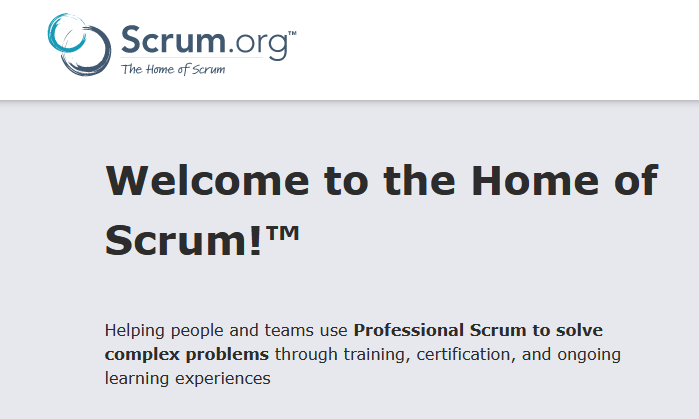Written by: Réka Pétercsák - PSM I, PSPO I, ACC, Certified SAFe 5 Program Consultant
How to take the PSM I™ and PSPO I™ exams?
Scrum.org's PSM I™ and PSPO I™ certifications are the first step for those who want to formally validate their basic agile knowledge and proficiency in the Scrum framework. They are therefore very useful for those who are just starting or changing careers and want to become a Project Manager, Product Owner or Scrum Master. However, professionals who have already spent a number of years in Agile frameworks can also make exciting discoveries about their knowledge of Agile and Scrum from the material covered in the exams. We've put together some tips that we and our training participants have used to make the preparation easier and support us during the 60 minutes of the exam.
IF YOU'D RATHER LISTEN OR WATCH THE CONTENT, CLICK ON THE VIDEO BELOW! (Hungarian version)
About the exams Professional Scrum Master I™ and Professional Scrum Product Owner I™
These exams provide the basic certification issued by Scrum.org. PSM I™ is popular among Scrum Masters, while PSPO I™ is popular among Product Owners. The exams have a good deal of overlap in their syllabus and question bank, but differ in their focus, i.e. they focus on different aspects of Scrum.
As a Scrum Master, your role is not only to support the team, but also the Product Owner, so your own development goals may include both exams. When choosing the right exam, you can also consider the Certified Scrum Master™ or Certified Scrum Product Owner™ exams, which measure a similar level of knowledge, and are issued by the Scrum Alliance, another organization. We are less against one of them and more in favour of Scrum.org's exams, PSM I ™ and PSPO I ™, because
- The organisation supports your preparation with a wealth of free information and a well-structured knowledge base
- Anyone can attempt the exam, it is not necessary to take an exam organised by Scrum.org
- It gives a widely accepted rating
- Building on real knowledge
If you would assess your knowledge, you can do it here a 30-minute survey.
How many people in the world have these qualifications? About this you can read here.
If you'd rather prove your intermediate or advanced Agile skills, you can choose the PMI-ACP, or the PMI-DASSM certifications.

How to get ready?
Prerequisites
There is no formal prerequisite to take the exam, which means that you can get the qualification by properly informing yourself on the internet, YouTube, scrum.org. What's more! The exam is an open-book exam, so you can have all the important study materials right next to you during the exam. However, it is worth knowing that the exam focuses on a deeper understanding of Agile principles and the Scrum framework, so most places strongly recommend that you take some kind of training where you can gain experience and a solid knowledge of how the principles and rules work. The exam is in English, so although it's not official, it is a requirement that you have at least a strong intermediate level of English when you take it.
Your key learning materials - all available for free
For the Professional Scrum Master I™ exam
- Scrum Guide
- Scrum Glossary
- Nexus Guide
- The Scrum.org compiled PSM I™ help guide
For the Professional Scrum Product Owner I™ exam
- Scrum Guide
- Scrum Glossary
- Nexus Guide
- EBM Guide
- The Scrum.org compiled PSPO I™ help guide
Except for the guide, the essential learning materials do not exceed 50 pages in total. The message is that this exam is really not about the amount of information you can memorize, but rather about whether you can really visualize the elements of the Scrum framework in action and know what the people involved do and why, taking into account the Agile principles and the Scrum rules.
Know what you have learned where!
Examples of such sites include:
- volkerdon.com
- Udemy
- https://mlapshin.com/index.php/scrum-quizzes/
Work through the most important lessons!
The fact that you can have the 14-page Scrum Guide (remember: the new 2020 Scrum Guide!) next to you during the exam is not necessarily helpful, as you will be asked 80 questions in 60 minutes, not much time to search. Work through the essential study material in advance with highlighters, notes and/or mindmaps so you know where to find what you need when you need it. Many people think that they can find the answers during an exam on Google search, but the source of these also varies, you may or may not find the right answer, and under time pressure it is difficult to assess how secure a source the page you have just clicked on is.
Interpret the questions you got wrong!
Whichever interface you practice on, after evaluating your mock exam, always interpret the questions you got wrong, i.e. trace the question or the correct answer back to what you read in the Scrum Guide or the Agile Manifesto. This will also help you to reinforce your knowledge and not lose points in the exam because you misremembered a question-answer pair.
Come to our training courses!
Our Scrum Master and Product Owner training courses give you the opportunity to prepare yourself professionally to ensure you obtain the PSM I™ or PSPO I™ certifications.

How to take the exam?
What should you watch out for in questions?
A good analysis of the exam questions can save you several points. We've listed the critical points where you could slip up and what to look out for:
- English auxiliaries: as in any English exam, always pay attention to the meaning of the auxiliaries (can/should/may/must). For example, whether a Product Owner has a role to play (should) or has the opportunity to do something (may) will influence the exact meaning of the question.
- Types of questions: there are currently three types of questions in the exam, 'Multiple Choice' - you have to choose the correct answer from several answers, 'Multiple Answer' - you have to choose one or more answers and 'True or False' - you have to decide whether a statement is true or false.
- How the question is asked: the way in which the question is formulated may vary depending on the above.
- Choose the best! Choose the best! In this exercise, you may find that you like several of the answers and find them logical.
- Which of the following is false? Which of the following is false? Most people get so used to looking for the best possible answer during practice that it takes them seconds to realise that the reason why there are so many good answers for this type of question is because the question was not about that. Don't waste time! Among the many tasks looking for the right answer, there are some that are looking for the wrong answer. Prepare for it and promise yourself now to always read exactly what the question is 😊.
- Select all that apply! Choose one or more! For these questions we don't know in advance how many answers will be correct, you have to guess.
- What should you do? What would you do? In the exam, especially in the case of PSPO I™, you may encounter several situational tasks where, after outlining a short situation, you are asked to indicate the logic you would use to solve the dilemma or the factors you would consider. Here too, always keep an eye on how many answers you are expected to give!
- Misleading questions: although not common, you may encounter questions that contain unnecessary information and can make you feel insecure. This shouldn't discourage you from reading the whole question, but it's good to be aware that wording such as: How long is a Sprint Planning if the Product Backlog Items are not clear? As a skilled practitioner, of course, you should know that the time frame for Sprint Planning is predefined in the Scrum framework, and although in practice teams may exceed the time frame, Scrum maximizes the length of events and this is independent of the status of the Product Backlog.
Time management
- Mark the questions you are not sure about, even in more than one way:
The exam system gives you the opportunity to 'flag' questions you are not absolutely sure about, so that you can come back to them later. Often you don't have enough time to return to all the questions you wanted to, and it's good to know which ones you were really unsure about. We recommend that you have a piece of paper next to you with the numbers 1 to 80 on it, and after each question, mark on it that you think A) you are sure you knew the answer B) you are a little unsure C) you have no idea. That way, when you get through the questions, you'll know straight away what you want to do with the rest of your time.
- Keep track of how much time has passed, check the clock regularly to check your progress:
More practised candidates can expect to spend around 15-20 minutes extra, but on average you will have 5-7 minutes to check after you have completed the 80 questions.
- Prepare yourself and the room for the exam:
Be fresh, whether it's in the morning or in the evening, have a secure internet connection, and ask family members not to disturb you for 60 minutes, and if possible, lock the door behind you.
Other information about the exam and application
-
- How much does it cost? You can find the current prices here:
-
- What percentage do you need to reach? 85%
- How many minutes do you have? 60 minutes
- How many questions do you get? 80
What happens when I apply? You can register and pay for the exam of your choice on Scrum.org. Within 24 hours you will receive a password to start the exam on Scrum.org. The password does not expire and can be used at any time, but it only entitles you to a single attempt.
What was your experience of the exam and your preparation? Let us know so we can add to this list! If you'd like to take the exam with our help, check out our current Scrum Master and Product Owner training courses and apply 🙂

 Designabc
Designabc